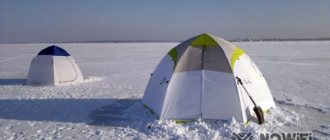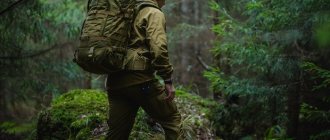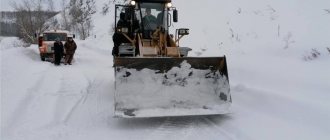How to survive in the forest for a long time in winter
The situation when a person finds himself without the minimum necessary means to survive in a winter forest does not happen often.
Here are the main reasons:
- He got lost or strayed from the group;
- Lost hiking equipment during a hike;
- His car or snowmobile breaks down (Figure 1);
- Unfavorable circumstances during the hunt.
Figure 1. You can get lost by simply straying from the group or not checking the snowmobile in time
. In any case, it will not be easy for someone who gets lost.
Don't eat berries if you're not sure about them
And yet, with a complete protein diet, complex carbohydrates should not be ignored. They promote the slow breakdown of glucose and the portioned injection of energy into the body, which is valuable for maintaining vital functions in a critical situation. You can’t count on vegetables and fruits in the winter forest, but you can quite easily find some berries. Just before you go, don’t forget to read or grab a page with information about berries growing in local regions. Poisoned or unripe fruits can, at best, cause indigestion, and at worst, severe intoxication, which will lead to vomiting (loss of nutrients), dehydration (loss of fluid) and weakening of the body (loss of energy and time to save).
How to organize an overnight stay in a winter forest
It gets dark quite early in winter, so you should prepare for the night in advance. If there is no chance of getting out to a populated area, you should start arranging a sleeping place immediately after lunch - from 15.00, since by 17.00 it will already be dark.
Experienced hunters and tourists advise what you need:
- Look around and find the optimal place for camp (Figure 3);
- Select one or a group of fallen trees;
- Dig a small cave for a fire under one of them;
- Clear the snow and lay down branches, since sleeping on bare ground will be cold;
- Coniferous tree branches are ideal for this purpose;
- If they are not available, use small twigs and dry grass;
- The thicker the improvised bed, the less chance you have of freezing;
- Cover the entrance to the shelter with branches;
- Alternatively, you can arrange a place in the roots of a fallen tree.
Figure 3. If there is deep snow cover, it can help us settle down for the night.
Don't sit on the snow, even if you want to sleep
Fatigue from a long walk and the desire to sleep can tempt a traveler to sit down (lie down) in the snow. This cannot be done, as the risk of total hypothermia and frostbite increases sharply. And if you really fall asleep in the snow, then your chances of escape in the winter forest will tend to zero. If fatigue takes over, and you don’t have the strength to form a fire and shelter, then force yourself with a strong-willed attitude. Come up with any motivation - fight for your life.
How to light a fire
If you can’t start a fire, don’t despair; physical heat is enough to last you until the morning at temperatures down to -15ºС.
But it would be better to try to light a fire in one of the following ways:
- If you have matches, a lighter or a woodcrash, you just need to find dry branches and grass or moss;
- Get a spark by friction using two dry sticks, spruce needles and a piece of dry wood or bark; instead of a rope, you can use your own laces to secure the device.
More experienced people who are familiar with the word “survive” firsthand have their own vision and recommendations.
Advice from experienced “survivalists”:
- Find dry needles under the snow - usually they are located within a radius of 1 m from spruce trunks;
- Collect dry moss - you need to look for it at the base of old stumps;
- Make a special thing that looks like a small bow (Figure 4);
- The string for an improvised chair can be any strong rope or cord;
- Take a non-wet, even stick and carefully bend it, making a loop from the slack on the bowstring;
- There is no need to tie a loop; you need to insert another stick into it;
- Next you need to find two pieces of wood that look like small planks;
- Place moss, existing pieces of paper and dried leaves on one of the boards;
- Place a piece of stick on the same board, pressing its end with a second board;
- Start moving the so-called bow to create friction;
- The fire will not flare up immediately, but after 10-15 minutes of intense work.
Figure 4. This is an ancient way to keep warm in the forest in winter.
In order not to look for firewood in the dark, you should make sure in advance that you have enough of it until the morning.
Don't drink cold water or eat snow
Extracting drinking water from forests at low temperatures is a difficult task. Drinking ice water or eating snow is strictly prohibited - diseases of the throat and upper respiratory tract are guaranteed, followed by fever and freezing. Before going into the winter forest, read a series of articles on how to properly find, collect, purify and heat water for drinking.
Surviving in the forest in winter is a very difficult and dangerous task, especially if you do not have successful experience in tourism at low temperatures, hunting in the taiga or other similar activities. Proper preparation, mastering some tricks and acquiring the necessary survival skills are necessary before starting your winter hike.
7 1
Survive in the forest in winter: getting food
Getting food is one of the conditions for successful survival. Not everyone may have a gun with ammunition or a food supply at hand, so you will have to look for alternative ways to feed yourself.
A good option for what you can do to get food is to make a snare:
- You will need any strong rope - twine, synthetic cord, wire or shoe lace;
- A loop is tied from it, which is firmly attached to a tree, a peg driven into the ground or a large stone;
- The loop should be such that a fist can easily fit into it;
- The snare is placed on the animal trail - where there are animal tracks, approximately 4 cm above the ground (Figure 5);
- Try not to touch the surrounding environment, set the trap with gloves, and do not leave traces;
- To rid the loop of human odor, fumigate it with smoke from a fire;
- Securely secure the trap, as the animal will try with all its might to escape from it.
Figure 5. If you don’t have a firearm at hand, snares are one of the ways to get meat.
Hunting is far from the only way to survive in winter, you can do gathering:
- For tea - pick up branches of wild raspberries, blueberries and blackberries, frozen rose hips;
- Meadowsweet leaves and 1-2 sprigs of wild rosemary are suitable; galangal uses roots - it can be identified by dried stems - these options are good if you know about plants;
- Chaga mushrooms grow on birch trees - from them you can prepare a healing nutritious infusion, which will also help against colds;
- As a last resort, branches of spruce, pine and cedar, and nuts from their cones are suitable;
- It is best to take running water for drinking water or melt clean snow.
How to survive in the forest in winter - use landmarks
If you happen to get lost, the first thing you should do is calm down. If there are no navigation aids listed above, your only landmark on the ground will be trees. Examine them carefully: the bark will always be darker on the north side.
Having determined the direction of movement, move forward so that every hundred meters you leave landmarks that are clearly understandable to you. As a rule, these are trees that stand out from the crowd in some way.
As you move forward, you should stop every few minutes to listen to the sounds coming. This could be the sound of an ax or train wheels, the noise of a motor or water stream, the whistle of a locomotive, someone's voices or screams, a dog barking, or the sound of a gunshot. In any case, try to walk with the goal of ending up on the bank of the river sooner or later. This will inevitably lead you to human habitation.
Survival in the forest in winter
You can find yourself in a winter forest without the usual survival kit in several cases:
if a person gets lost due to a coincidence of unpleasant circumstances, means of survival are lost during a planned winter hike, a car or snowmobile breaks down during a winter hunt
The last case refers to situations with the most favorable prognosis, since usually the car is left outside the boundaries of the forest, therefore, in such an area it is easier to find the road to the nearest populated area than in the forest. Let's look at situations where you can survive in the forest in winter without anything.
First steps if you get lost
How to survive in the forest From the very first moment, as soon as you began to understand that you are completely unfamiliar with the area, one thing remains important - do not panic. It is necessary to stop moving and use a compass or map, if available. But, as a rule, if you have a compass with you, it is not particularly difficult to navigate an unfamiliar area. Without a compass, you need to try to find the north direction. In winter, you can only navigate by tree bark, since other signs “work” in the warm season. Therefore, you can observe which side of the tree trunks the bark is darker in order to orient yourself to the north.
It is extremely difficult to move through the snowy forest. And therefore, in order not to climb into the impassable jungle, you need to choose large and noticeable landmarks for yourself every hundred meters, and at night choose the silhouettes of large trees as them.
Since the main goal is to get to the nearest settlement, it is necessary to stick to the flow of the river, if there is one, or the least dense areas of the forest.
Organization of overnight stay
How to survive in the forest without anything in winter If there is no chance of getting out of the forest in the next couple of hours, you need to prepare for an overnight stay, since this will be difficult to do at night. To do this, it is better to find one or a group of fallen trees. Under one of them it will be possible to dig a hole for making a fire. You can also choose a location near a slope or hill. The main thing is that the height of the “platform” to the ground is at least 50 cm. The bottom of the improvised hut needs to be covered with spruce branches, and the top of the hut is also covered with them as tightly as possible. The fire will be built inside, so the branches should be at a safe distance from the fire.
Another option for making a shelter is from snow. You need to find a snowdrift of dense snow and start laying a hut out of it along the required perimeter. Such a shelter can keep the temperature inside higher than a hut made of branches and wood. But you can't light a fire inside it.
Yandex.DirectTent Totem Bluebird from 1400rmarket.yandex.ru Design of fire extinguishing systemspojarka-gard.ru Nanocad OPS programmst.su 18+
Lighting a fire
Lighting a fire in the forest in winter You can’t survive in winter without a warming fire. It can be obtained in two ways: using matches or a lighter, if you have them, or by friction. Making fire by friction is a rather labor-intensive task. To do this, you need to find tinder, which can be dry moss, fibers from dry birch bark, dry spruce needles, fibers from your own clothes, cotton wool. To make a bow you will need any rope or cord, as well as two wooden sticks. An arc with a stretched rope is made from one of them, in the middle of which a second stick is inserted vertically using a loop. You need to place tinder on a wooden base, then use the bow to make active rotational movements. As a result of friction, the tinder should begin to smoke; it should be placed in the main part of the firewood and fanned until fire appears. Firewood should consist of dry tree bark, dry branches, and logs from fallen trees.
Another way to make fire is to use a lens. To do this, you need to find a transparent ice floe and tinder made of dry moss, twigs, and grass. This method is used only on a sunny day, when the sun's ray is directed onto an ice lens and focused on dry tinder. After some time it will flare up, all that remains is to support it to light a large fire.
Survive in the forest in winter: getting food
Getting food If thirst sets in, you should never eat snow. If there is no water, you need to collect snow in a plastic bottle or other container and place it on your outerwear. When the snow melts, you can drink it. If you don’t have any container with you, then you need to put snow in your mouth and keep it there, without swallowing, until it warms up. If you eat snow in its solid state, there is a high risk of getting a sore throat and reducing body temperature, which is very dangerous in the forest in winter.
In addition, you can melt snow and brew tea from branches of wild raspberries, rose hips, blueberries, lingonberries, and wild rosemary. Many of these plants with fruits can be found in early winter until severe frosts. It is also very good to use chaga, a tree mushroom, for infusion - it relieves cold symptoms. For the same purposes, you can boil the tips of spruce, pine, and cedar.
The situation with food in winter is more complicated than in summer. If winter is early, tree mushrooms may remain on the bark of trees, as well as wild berries on bushes, as well as acorns. There are a lot of cones and pine nuts in the coniferous forest. Not far from trees, as well as in thawed areas, you can use a stick to dig out worms, which are a rich source of protein. It is unlikely that you will be able to hunt large prey in the forest without special equipment and weapons, but you should try to track small prey such as gophers and other rodents through their burrows, which look like mounds. Since it is difficult to catch a rodent without a snare, you can fill its hole with water or blow smoke into it, after which the prey will come into your hands. If you have fishing line or nylon rope with you, you can make a trap for partridge, hazel grouse or pheasant. For small forest game, you can also make a snare by making a loop and attaching it to a tree, a strong post or a stone. Of course, you need to take into account the animal’s permeability in this particular place, which can be calculated from numerous tracks and trails, especially if the snow is fresh and soft. The loop must be made in such a way that it immediately tightens on the animal’s limb as soon as it gets into it.
Yandex.DirectCossack “Plastun” knife on sale!plastun.legendary-knives.rf Products structurally similar to weapons Nanocad OPS programmst.su 18+
How to survive in the forest in winter: ways to warm up
How to survive in the forest in winter: ways to warm up Finding yourself in the forest during the cold season, it would be logical to assume that a person will be dressed for winter. However, the main thing when surviving in the forest is to stay warm, in other words, to move. The heat that the body produces when performing physical exercise is enough to survive at minus fifteen degrees. To control the degree of hypothermia, you need to periodically bring your index finger and little finger together: if they are brought together with difficulty, this is a dangerous signal that the body is close to hypothermia.
If you feel like you're starting to freeze, you can do some squats. If you have any other things with you, you can put them on. It is very dangerous to get your feet wet. You need to breathe only through your nose.
In addition, to warm up, you can perform special breathing exercises. To do this, you need to sit on the ground, press your left leg to your body, and place your right leg parallel to it. The foot of the left leg must be pressed as close as possible to the inner surface of the right thigh. At the same time, your knees should be wide apart and your hands should rest on them, palms up. When the pose is accepted, you need to start breathing rhythmically with your stomach so that there is practically no gap between inhalation and exhalation. For the first two minutes you need to try to breathe this way, then you need to slow down your breathing. In this way, you need to breathe for another three minutes. Then return to your normal breathing rhythm, and repeat the exercise five minutes later. Thus, after the second repetition, you can feel the increase in heat in the body. This breathing practice can be done any number of times to keep warm in harsh environmental conditions.
In any case, if you suddenly experience severe drowsiness or attacks of fatigue, under no circumstances should you stop, sit down, or lie down in the snow.
By following the above tips, you will survive at least a week until you can find the slightest sign that a way out to the nearest populated area has been found.











